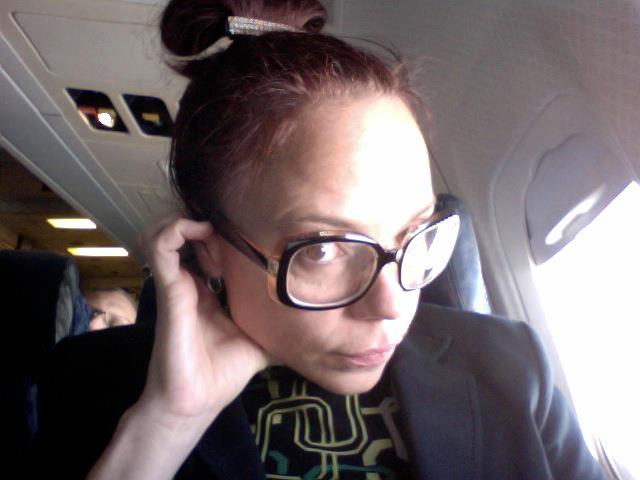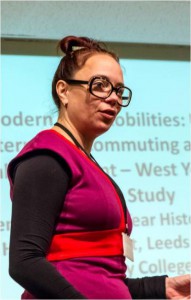
Assistant Professor of Aesthetic Studies, The University of Texas, Dallas
You are an expert in the history of art and architecture. How did you come to cross the history of mobility?
I went to the T2M conference in 2007 in Helmond, NL to present a paper I had developed on photo-textual works of conceptual art that are centered around views to the road. This became the noyau of my forthcoming book, Automotive Prosthetic: The Car, Conceptual Art and Technological Mediation (University of Texas Press, 2013)
What is the role held by art in the so called “mobility turn”?
I am not exactly certain. I don’t think there are a lot of art historians interested in traffic, transportation, and art. Contemporary artists and theorists like myself, however, are interested in the philosophical role of mobility as kinetics within art as well as questions of infrastructure, architecture, and landscape. To us “mobility” does not just concern transportation, but mutation, the dynamism of culture, and the philosophical idea of “becoming.”
When thinking about art and mobility, you can refer to the representation or use of transport systems by artists (Impressionists and railways, Ant Farm and the Cadillac, etc.) but also to transport systems as artistic productions, particularly cars. Would you share this idea and do you think that bridges can be found between these two points of view?
Objectively and empirically — yes they can be made. However methodologically and perhaps also ideologically it is quite difficult to meld disciplines. Questions of form, abstraction and aesthetics are sometimes foreign to certain areas of scholarly practice while, conversely, questions of policy are foreign to others. While difficult to make these ends meet, it is possible.
You also work as curator or critic. How would you compare a museum of art with a museum of transport? Do you think that borders can be crossed?
The common zone between museums of art and transportation unfolds around the word “media” : that is to say, the overlap between the artistic medium and the mediation of bodies and information. The art museum tends to deal with the former while museums of transportation deal with the latter. Very interesting things happen when both types of institutions unwed themselves from the conventional artefact and focus on the fluidity of “media” — i.e. modes of mediation and communication taking form in works of art and modes of technology in the present and future. A great example of this singular fusion occurred at the Center for Art and Media [KZM] in Karlsruhe, Germany with the exhibition Car Culture (2011).
What is your preferred museum?
My answer is not written in stone — my preferences change over time. Right now, I really enjoy media-art museums like the Center for Art and Media in Karlsruhe. I think intermedia museums are in tune with life in the current moment, and this is because of their attention to contemporary technology and mix of art and technology. In terms of programming, they seem to be following trends of art museums, institutions of contemporary art and those with broad, diverse cross-temporal collections. I’ve watched art museums all around the world struggle over the last decade with educational mandates — ie “keeping the numbers up” in terms of attendance — in order to bring in revenue and keep doors open. While I’ve witnessed this in western Europe, it is most profoundly felt and experienced in the United States. Programming in American art museums cannot be uni-dimensional; museums cannot stand inert or empty. Our State does not support them; most monies come from private sources and, unfortunately, ticket sales. Even if I don’t always support this approach, it has a tendency to keep institutions up to date and ‘on their toes,’ often creating a vitality that might not otherwise be present.
I think there is a unique and important vibrancy in mixed media spaces — museums or institutions that do not consider themselves mausoleums of dead artifacts but living community nodes that teach and experiment with new ideas. T2M should be dedicated to having their yearly conference in spaces like this — devoted to the present and the future as much as to the past.
How do feel in our association as a specialist of art?
To be honest, most of the time, I feel out of place. I am not certain my engineering cohorts in T2M know the breadth and seriousness of art as a scholarly discourse. There are 1,000s of us art/architecture scholars around the world. You don’t see them at conferences like T2M because most are less likely to intermix art, infrastructure, and urbanism like I do.
I have gone to several T2M conferences because I like traveling, exchanging new ideas, presenting my work, and hanging out with internationals. In Madrid, I found the temporal investigations of Andrey Vozyanov and global/local theme of Tomás Errázuriz’s paper most interesting. But this might seem slightly self-serving insomuch as we shared a panel. I also enjoyed discoursing with the Victorianists Diane Drummond and Teresa Crompton. I think this motley group reveals a great strength of T2M that must be encouraged and enhanced: diversity of ideas and methodologies.
What do you think about the future of our association?
I think T2M must diversify its contents and leadership, opening itself up to people of different origins and genders not just at the level of the presentation of papers but at the top — the leadership. The contents of publications and conferences must also diversify in order to modernize the group. The central theme of “technology” should be broadened to include digital mobility and means of communication from Edison to Jobs. There should be an openness to telematic ideas — work on the new mobilities created by the internet. The group should encourage greater participation of the deep humanities — literature, art, cultural studies, philosophy — by pushing conference themes away from literalist notions of movement (which seems to unfold so often around the train) to more imaginative, broad-based ideas of mobility that would include everything from hopscotch to entropy.
 Photo by Keith Harcourt © T2M 2012.
Photo by Keith Harcourt © T2M 2012.